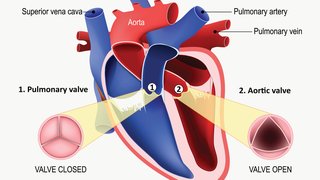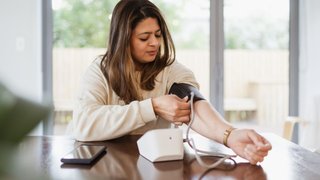Pushing aside ‘Stayin’ Alive’: New songs to keep the (heart)beat during CPR
February 27, 2025
You might consider some songs life-changing, but did you know they could be lifesaving?
For years, “Stayin’ Alive” by the Bee Gees reigned as the go-to anthem of hands-only CPR training. Clocking in at about 104 beats per minute (BPM), the song sets the perfect tempo to keep time with chest compressions, which is between 100 to 120 BPM. Its usefulness as a resuscitation tool was even referenced in a memorable scene from “The Office.”
But as the 1977 disco hit approaches 50 years old, it might be time to cut the (aux) cord and find a more modern metronome. And in medical emergencies like cardiac arrests, when every second matters, the song is only as useful as it is familiar, so choose an earworm that’s hard to shake.
And if you think it is unlikely you will ever face such an urgent dilemma, remember that more than 300,000 Americans suffer from cardiac arrest outside of a hospital every year. When this occurs, blood flow to the brain, the lungs, and all other organs halts. Only about 10% of these individuals survive. That’s when CPR becomes vital to recirculating blood and giving them a better chance.
Cardiac arrest can happen suddenly to anyone. Sometimes, hands-only CPR means the difference between life and death. This is a lesson I learned firsthand.
I was 25 years old and about to start a fellowship in cardiovascular medicine when I collapsed at the gym during a basketball game. My heart stopped, but by the grace of God, bystanders knew exactly what to do. Someone called 911, and another person began performing chest compressions. The gym also had an automated external defibrillator (AED), which attempted to restart my heart before EMTs arrived. Thanks to their collective efforts, I was able to recover fully. Today, I try to pay their actions forward daily by giving the best possible care I can to my patients.
Acting during an emergency can seem like a daunting responsibility, but hands-only CPR essentially comes down to two key steps: Alert 911, and push hard and fast on the person’s chest until help arrives. If done immediately, it is just as effective as traditional CPR, according to the American Heart Association (AHA).
However, just as your heartbeat follows a certain pace, so should chest compressions. Calculating the speed of 100 to 120 beats per minute can be hard, but counting to the beat of your favorite song tends to come naturally to people.

Practicing hands-only CPR
UT Southwestern celebrated Heart Month in February with a hands-only CPR demonstration with Amit Khera, M.D, (left) Director of UT Southwestern’s Preventive Cardiology Program and Chief of Cardiology Clinical Operations, and others. See how easy it is to do compressions and keep pace with your favorite songs.
Heart-pumping songs through the decades
Fortunately, there is no shortage of tunes to choose from. The only rule of thumb is to find one with 100 to 120 BPM. The AHA even created a Spotify playlist of more than 160 song suggestions. So, whether you are Gen Z or X, a fan of country music or pop, there is something that is sure to be familiar to you. Here are some options:
Songs from the 1980s
“Billie Jean” by Michael Jackson
“Eye of the Tiger” by Survivor
“Don't Stop Believin'” by Journey
“Last Christmas” by Wham!
“I Wanna Dance with Somebody” by Whitney Houston
“The Final Countdown” by Europe
"Every Breath You Take” by The Police
Songs from the 1990s
“All Star” by Smash Mouth
“Wannabe” by Spice Girls
"This Is How We Do It" by Montell Jordan
“Ice Ice Baby” by Vanilla Ice
“Macarena” by Los Del Río
“Intergalactic” by Beastie Boys
“Gettin' Jiggy Wit It” by Will Smith
Songs from the 2000s
"1, 2 Step" by Ciara, featuring Missy Elliott
“Summer Nights” by Rascal Flatts
“Just Push Play” by Aerosmith
“Move Along” by All-American Rejects
“Poker Face” by Lady Gaga
“Hips Don’t Lie” by Shakira, featuring Wyclef Jean
“Jenny from the Block” by Jennifer Lopez
Songs from the 2010s
“Passionfruit” by Drake
“Overcomer” by Mandisa
“Baby Shark” Pinkfong’s version
“Can’t Stop the Feeling!” by Justin Timberlake
“All About Tonight” by Blake Shelton
“Uptown Funk” by Mark Ronson, featuring Bruno Mars
“Rolling in the Deep” by Adele
Songs from the 2020s
“Not Like Us” by Kendrick Lamar
“The Tortured Poets Department” by Taylor Swift
“Liar” by Jelly Roll
“Espresso” by Sabrina Carpenter
“Pink Pony Club” by Chappell Roan
"Texas Hold 'Em" by Beyoncé
“Birds of a Feather” by Billie Eilish
General tips to remember with hands-only CPR
Research shows
An international research consortium that included UT Southwestern Emergency Medicine published a study in JAMA Cardiology in 2019 that found that the optimal depth for each push during CPR is about two inches.
Act fast: One of the most frequently asked questions I hear is, “How can I tell whether I should step in?” There are generally two major signs of cardiac arrest:
- If a person is unresponsive
- If he or she has stopped breathing or is breathing abnormally
Those are indications that you should begin CPR immediately. Most of these incidents happen at home, where a family member might be around to render care. In public spaces, people tend to be slower to respond out of wariness or uncertainty. But in cases like these, inaction has far more devastating consequences than intervening.
Push effectively: To administer CPR properly, you should place the heel of one hand on the breastbone in the center of the chest. Place your other hand over the first, palm down, and interlock your fingers. Positioning your shoulders directly over the person’s chest and keeping your arms straight will help with stamina and momentum. (This method is primarily for teenagers and adults. Young children and infants will require less force but still the same number of beats.)
Locate an AED, if one is on-site: An AED, or automated external defibrillator, is a portable medical device used to deliver an electric shock to the heart to restore its normal rhythm. It comes in an easy-to-carry case and can be found in certain places such as gyms, schools, and airports. These packs include adhesive electrode pads, which, when attached to the victim’s chest, allow the machine to analyze the heartbeat and tell you when a “shock” is needed. In the best-case scenario, there will be multiple people around to help, and one person can call 911 and fetch an AED while someone else administers CPR. But if you’re alone, prioritize calling 911 and CPR rather than searching for an AED.
As a cardiologist, I see the importance of CPR every single day. Cardiac arrest can strike suddenly, no matter your age or physique. Damar Hamlin, a prime athlete who plays safety for the Buffalo Bills, was not yet 25 when his heart stopped after a hit during an NFL game in January 2023. Fortunately, Mr. Hamlin was surrounded by medical personnel who immediately stepped in to perform CPR and rushed him to a hospital. Each year, thousands of Americans suffer cardiac arrests – many of whom ultimately lose their lives.
But it doesn’t have to be a lost cause. Research shows that people who receive bystander CPR have a much better chance of survival. Even a basic understanding of hands-only CPR can make a difference, and it’s a tool worth teaching to the entire household.
Related stories:
Cardiac ablation for AFib: The latest techniques to keep your heart in rhythm
Destiny's patient: A heart-stopping story of survival at UT Southwestern
Leadless dual-chamber pacemaker is a leap forward for heart patients
To talk with a cardiologist, schedule an appointment by calling 469-884-6282 or request an appointment online.











